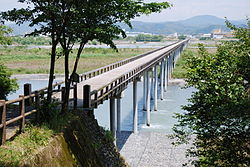Shimada, Shizuoka
Shimada
島田市 | |
|---|---|
 Hōrai Bridge in Shimada | |
|
UTC+9 (Japan Standard Time) | |
| Symbols | |
| • Tree | Osmanthus |
| • Flowers | Rose, azalea |
| • Bird | Blue-and-white flycatcher |
| Phone number | 0547-37-8200 |
| Address | 1-1 Chūō-chō, Shimada-shi, Shizuoka-ken 427-8501 |
| Website | Official website |

| Shimada, Shizuoka | |||||
|---|---|---|---|---|---|
| Japanese name | |||||
| Kanji | 島田市 | ||||
| Hiragana | しまだし | ||||
| Katakana | シマダシ | ||||
| |||||
Shimada (島田市, Shimada-shi) is a city located in Shizuoka Prefecture, Japan. The city, which covers an area of 315.7 square kilometres (121.9 sq mi), had an estimated population in September 2023 of 93,724, giving a population density of About 300 persons per km2.
Geography
Shimada is located in the Shida Plains of west-central Shizuoka Prefecture. It is located on both banks of the
Surrounding municipalities
Shizuoka Prefecture
- Aoi-ku, Shizuoka
- Tenryū-ku, Hamamatsu
- Fujieda
- Kakegawa
- Kikugawa
- Makinohara
- Yaizu
- Yoshida, Haibara District
- Kawanehon, Haibara District
- Shuchi District
Demographics
Per Japanese census data,[1] the population of Shimada has remained steady over the past 50 years.
| Year | Pop. | ±% |
|---|---|---|
| 1940 | 68,753 | — |
| 1950 | 86,704 | +26.1% |
| 1960 | 94,272 | +8.7% |
| 1970 | 96,613 | +2.5% |
| 1980 | 100,519 | +4.0% |
| 1990 | 103,149 | +2.6% |
| 2000 | 102,585 | −0.5% |
| 2010 | 100,250 | −2.3% |
Climate
The city has a climate characterized by hot and humid summers, and relatively mild winters (Köppen climate classification Cfa). The average annual temperature in Shimada is 15.7 °C. The average annual rainfall is 2142 mm with September as the wettest month. The temperatures are highest on average in August, at around 26.5 °C, and lowest in January, at around 5.2 °C.[2]
History
Shimada (Kanaya) began as an outlying fortification to
With the establishment of the modern municipalities system in the early
Shimada was elevated to city status on January 1, 1948. On January 1, 1955, it annexed neighboring Rokugō Village, Ōtsu Village, Daichō Village and a portion of Ikumi Village. On June 1, 1961 it further expanded through annexation of Hatsukura Village.
On May 1, 2005, the town of Kanaya (from Haibara District) was merged into Shimada.
On April 1, 2008, the town of Kawane (also from Haibara District) was also merged into Shimada.
On March 15, 2012, the city became the second municipality, after Tokyo, outside
Government
Shimada has a
Economy
The economy of Shimada is primarily agricultural, with green tea as the main crop. Light industries of Shimada include factories for the production of automobile components.
Education
Shimada has 18 public elementary schools and seven middle schools operated by the city government and one middle school operated by the national government. The city has four public high schools operated by the Shizuoka Prefectural Board of Education, and one private high school. The prefecture also operates one special education school for the handicapped.
Transportation
Railway
Highway
Airport
International relations
Shimada is twinned with the following cities:
 Himi, Toyama, Japan, from April 15, 1987
Himi, Toyama, Japan, from April 15, 1987 Huzhou, Zhejiang, China,[4] from May 1987
Huzhou, Zhejiang, China,[4] from May 1987 Brienz, Switzerland,[4] from August 10, 1996
Brienz, Switzerland,[4] from August 10, 1996 Richmond, California, United States, from December 1961. There is currently a student exchange program between Shimada and Richmond.
Richmond, California, United States, from December 1961. There is currently a student exchange program between Shimada and Richmond.
Local attractions
- Hōrai Bridge
- Ōigawa Railway
- Suwahara Castle ruins, a National Historic Site
Notable people from Shimada
- Masafumi Gotō, musician
- Tarzan Goto, professional wrestler
- Horiyoshi III, Irezumi tattoo artist[5]
- Hub, professional wrestler
- Takahiro Kawamura, professional football player
- Kayoko Kishimoto, actress
- SixTONES
- Sho Naruoka, professional football player
- Minato Oike, BMX freestyle cyclist[6]
- Hirotoki Onozawa, professional rugby player
- Masaki Yamamoto, professional football player
References
- ^ Shimada population statistics
- ^ Shimada climate data
- Japan Times, 16 March 2012, p. 1.
- ^ a b "International Exchange". List of Affiliation Partners within Prefectures. Council of Local Authorities for International Relations (CLAIR). Archived from the original on 13 January 2016. Retrieved 21 November 2015.
- ^ "西区TATTOO STUDIOの「三代目 彫よし」とはどんな方?". はまれぽ.com (in Japanese). 2012-12-14. Retrieved 2023-04-26.
- ^ "Cycling BMX Freestyle OIKE Minato - Tokyo 2020 Olympics". olympics.com. Archived from the original on 1 August 2021. Retrieved 1 August 2021.
External links
- Official website (in Japanese)
- Shimada City official website (in English)
 Geographic data related to Shimada, Shizuoka at OpenStreetMap
Geographic data related to Shimada, Shizuoka at OpenStreetMap
